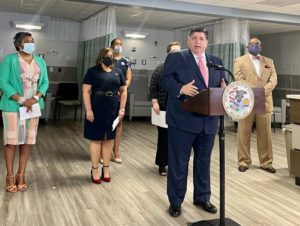Education pension spiking costs continue to hit Illinois taxpayers
(The Center Square) – School districts across the state continue to divert money from classrooms to boost the pensions of retiring educators despite multiple attempts to curb the practice.
One…

(The Center Square) – School districts across the state continue to divert money from classrooms to boost the pensions of retiring educators despite multiple attempts to curb the practice.
One district even paid out more in pension penalties than it spent on a contract with a textbook publisher.
The state’s locally controlled public schools paid millions of dollars in penalties each year directly to the state’s largest pension fund for giving out raises and sick time in excess of the threshold set by a 2005 state law designed to discourage what is commonly known as pension spiking.
School districts sent $8,839,754.35 to the Teachers’ Retirement System of the state of Illinois to cover the cost of excess salary and excess sick time payments given to educators at the end of their careers in years 2018-2019 and 2019-2020, according to records obtained by The Center Square. That’s on top of the more than $50 million in penalties districts have paid to TRS since the 2005 law passed, including $23.8 million since fiscal 2014. But districts only paid a fraction of what they actually owed due to exemptions built into the 2005 law.
“In the first 10 years of the program, 2005 to 2015, the excess salary contributions levied against school districts totaled $149.5 million, or an average of $14.95 million per year,” said Dave Urbanek, director of communications for the Teachers’ Retirement System of the state of Illinois. “However, because of exemptions to the 6% threshold built into the law at that time, districts paid only $39 million during that decade, or an average of $3.9 million per year.”
State Sen. Craig Wilcox, R-McHenry, said some local taxpayers probably aren’t aware of how school districts are spending tax dollars. The majority of school district funding in Illinois comes from local property taxes. Most national analyses show Illinois residents pay, on average, the second highest property taxes in the U.S., behind only New Jersey.
Wilcox said additional transparency rules, such as requiring districts to publish information about raises above 6% that would spike an employee’s pension, could help reduce pension spiking.
“I’d be curious to know how many people in the local community know about these raises,” he said.
The 2005 law penalized the practice of doling out hefty end-of-career raises to retiring educators, who would then get larger taxpayer-funded pension checks from the state. The law said that school districts would have to pay the cost difference for salary increases of more than 6% a year, essentially shifting the cost back to the local school district taxpayers. School boards could still give out raises of more than 6% in the years before retirement, but their taxpayers had to pay for the additional pension costs. The law requires local taxpayers to pay the state’s Teachers’ Retirement System for the full actuarial value that the system expected to incur from the higher salary. Urbanek said the direct payments are not penalties, but excess costs.
“It is safe to say that all districts are very aware of the 6% threshold and the costs the law imposes for granting raises in excess of the threshold. This is especially true when a school district’s budget is tight,” he said. “Also, the media’s mistaken, but widespread, identification of the 6% threshold as a ‘penalty’ creates a headline risk that school districts shy away from when making decisions. The excess cost is not a ‘penalty’ because a district is not doing anything illegal in granting a raise above 6%. Granting that raise is a conscious decision that generates a ‘cost,’ much like making a conscious decision to buy a six pack of beer. You have to pay the relevant taxes for that decision and that’s an ‘excess cost.'”
When The Center Square first looked at the issue in 2018, some school district officials called the threshold a penalty.
“We look at this as a penalty,” Huntley District 158 Chief Financial Officer and Treasurer Mark Altmayer told The Center Square at the time.
In 2018, lawmakers attempted to further discourage pension spiking by lowering the cap to 3%. That 3% cap was included in the 1,245-page state budget that lawmakers passed through both chambers in May 2018. Then-Gov. Bruce Rauner signed the budget into law, but the 3% cap was never implemented, TRS officials said. The 3% cap was projected to save Illinois taxpayers $21 million across all pension funds. Lawmakers reversed course when they brought back the 6% cap in the 2019 budget bill, which Gov. J.B. Pritzker signed into law. The changes created confusion for districts across the state, Urbanek said.
“For months TRS undertook an extensive communications effort to inform districts that the law was coming. That started in June of 2018. And then in June of 2019, before the 3% threshold was implemented, the General Assembly repealed it,” he said. “We had to re-write our communications to say, ‘never mind.’ The 3% law itself was a little complicated for everyone to implement because for districts with collective bargaining agreements in place prior to June of 2018, the 3% law did not apply. They were still under the 6% law. They had to wait until a new [collective bargaining agreement] was agreed to before the 3% threshold would apply. So TRS spent a lot of time with districts helping them determine whether they should apply the 6% threshold or the 3% threshold.”
The Illinois Education Association, which represents more than 135,000 educators, helped lead the charge to return the salary cap to 6%. The group said the 3% cap punished teachers for taking on additional responsibilities that boosted their pay during the final years of their careers. The teacher-union backed group also said the 3% cap made it more difficult to attract and retain teachers.
“Districts worry about being charged if a teacher’s salary increase affects their pension, which means they are keeping raises at, or below, 3% regardless of the additional work teachers may take on, degrees they may earn or certification they work for,” the organization wrote in a post at the time urging members to help repeal the lower cap. “So districts are opting to skip any raise over 3% to make sure they won’t be charged. We are seeing it all over the state.”
Illinois teachers made an average salary of $68,305 in 2020, ninth highest in the country, according to Business.org.
Wilcox said the 3% cap would have helped prevent pension spiking.
“That was the smart way to go,” he said. “That would have changed the calculus for school districts.”
Some school districts avoided penalty payments altogether during the two year period reviewed by The Center Square. Districts that continued to hand out big raises to retiring educators were required to pay TRS tens of thousands of dollars to the pension system year after year.
Of the state’s more than 850 school districts, 510 paid excess salary or excess sick time payments directly to TRS during the years reviewed by The Center Square. Many of the districts paid nominal amounts. For example, Lansing School District 158, which serves about 2,500 students in five schools in Cook County near the Indiana border, paid $10.25 to TRS for excess salary raises in 2018-19 and $418.89 the following year.
The penalty amounts varied by school district. Larger districts tended to pay more while smaller districts tended to pay less. But not always. Paw Paw CUSD 271, which serves about 100 students in two schools in Lee County, paid $49,068.78 directly to TRS during the two fiscal years.
Even some state agencies had to pay pension penalties. The Illinois State Board of Education paid TRS $202,493.45 over the course of the two fiscal years. The Illinois Department of Corrections paid $20,491.89.
Larger districts ended up paying more directly to TRS. Rockford School District 205, which serves about 26,000 students in 44 schools, paid TRS $452,965.19 in pension and excess sick time penalties over the two fiscal years. The average teacher salary in the district was $62,570, according to the Illinois State Board of Education. A spokesperson for the district did not answer questions about the costs. Those costs are on top of more than $1.1 million in excess pay increase or sick day penalties the district has paid since 2013, according to TRS documents.
Elgin School District U-46, which serves 36,000 students in 53 schools, paid TRS $393,256.62 in total penalties in the two fiscal years. U-46 Financial Operations Director Dale Burnidge did not respond to questions about the district’s payments to TRS. The average teacher salary in the district is $73,951, according to state records.
Waukegan Community Unified School District 60, which serves about 14,300 students at 22 schools, paid TRS $341,982.78 in the two fiscal years. Gwendolyn Polk, associate superintendent of business and financial services for the district, did not respond to questions about the payments. By contrast, the Waukegan district’s most recent contract with McGraw Hill, one of the nation’s largest educational publishers, totaled $278,777.23, according to the district’s website.
State Rep. Mark Batinick, R-Plainfield, said some end-of-career raises in excess of the 6% cap may be justified, such as when a teacher takes on a coaching job.
Batinick said one solution that could help protect the state’s underfunded pension system would be to create a system for new teachers that includes higher pay at the beginning of their careers rather than large end-of-career spikes. He said such a system also could help recruit more teachers in Illinois.



